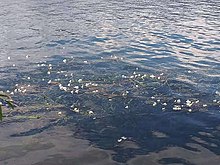Lugu Lake
Lugu Lake (simplified Chinese: 泸沽湖; traditional Chinese: 瀘沽湖; pinyin: Lúgū Hú) is located in the northwest of the Yunnan plateau, with the middle of the lake forming the border between the Ninglang County of Yunnan Province and the Yanyuan County of Sichuan Province.
The most numerous of these are the Mosuo people (also spelt "Moso"), said to be a sub clan of the Naxi people (as per Chinese records of Minorities in China) with ancient family structure considered as "a live fossil for researching the marital development history of Human beings" and "the last quaint Realm of Matriarchy."
The Lion Mountain that surrounds the lake, which is worshipped as the goddess Gammo, is the chief deity of the Mosuo people who inhabit the area.
[2][4][5][12][13][15] The Gaizu River, flowing out of the lake at its southeast end, has a controlled outlet that is only operated during the rainy season and remains closed from September to May.
Lugu Lake is snowbound for three months a year; in the autumn and spring, it has a cool and dry climate with warm daytime temperatures.
[4][5][6][11][12] The winding shoreline of the lake is occupied by several ethnic minorities belonging to the Mosuo, Norzu, Yi, and Pumi tribes.
The lake is 200 kilometres (120 mi) away from the Lijiang city, the headquarters of the Ninglang province, along a road that passes through some of the most scenic sights en route between Zhongdian and Dequin.
[6][11] The history of the place, however, is also well known for its matriarchal culture and also the dress of the Mosuo women and girls in particular, which is distinctly conspicuous for its maroon blouses and skirts that establish an aura of authority.
Kublai Khan introduced Buddhism and enforced rules of civil administration, coupled with religious tenets around Lugu Lake and Yongning.
It was during this time that the practice of monogamous marriage practised by officials of Mongol army also came into vogue among the ethnic Mosuo people, particularly in the Yankouba and Tuodian villages.
When he found her in the company of a local male spirit, he felt humiliated and quickly turned his horse round and started going back.
As it was getting dark, Gemu could not proceed further and she started weeping frenziedly, which resulted in the hoofprint turning into a lake with her tears.
In order to escape discovery of their affair, Waru Shila fled from the scene on his horse towards the hill, while Gemu fondly looked at him from the shore of Lugu Lake.
[14] Lugu Lake, set in the subalpine zone in the southern Hengduan Mountains, is a pine-covered ecoregion.
Apart from hosting endemic species of fish, Lugu Lake is visited by wintering water birds.
[4] Black-necked cranes (Grus nigricollis) are found in the Lugu Lake area which is under the Vu (vulnerable category as per IUCN).
The studies reported that there are now 12 fish species in Lugu Lake, which belong to 10 genera, four families and three orders.
The main reasons attributed for this decline are the heavy deforestation that occurred once in 1970 and then again between 1980 and 1990, which caused heavy siltation of the lake; the siltation advanced 100 metres (330 ft) into the lake causing destruction of many spawning grounds of the three Schizothorax fishes, followed by the decrease of their stocks.
[16] Yang Erche Namu, a Chinese born in a small village near Lugu Lake, is a famous writer and singer of Mosuo ethnicity.
And today, the area around Lugu Lake, the Mosuo homeland where Namu grew up, has become a chic tourist destination, thanks almost entirely to the renown that Namu's book has brought it.”[19] She had even proposed to the then divorced French president Nicolas Sarkozy during his visit to China; in a recorded video introduction uploaded to the internet, she praised the colour of his skin and stated that she would be "a perfect wife for him".
Any body desecrating the lake, as a reparation, has to sacrifice an animal used in tilling and offer the meat to the villagers to eat, contact a “dingba or hangui, a shaman, to appease the spirits and restore topo-cosmic harmony” and pay obeisance to a Tibetan Buddhist Lama or local Lama.
It passes under the shadow of Mount Gama, trees wound with multicoloured cloths, rainbow coloured Buddhist prayer flags with an animal symbol and Buddhist scriptures printed on them, rows of pine trees, pig trough canoes on the lake, wooden houses with upturned roofs (similar to those found in Lijiang city), agricultural land of red soils, white gulls on the lake waters; a change of territory into Sichuan from Yunnan region, pyramidal stupas made with square segments affixed with flat prayer inscribed stones; the Lama Temple (a three tiered red and white Buddhist structure with upturned eaves surrounded by colourful fluttering prayer flags and a 15 feet (4.6 m) fresco with a monk praying amidst scenic surroundings of mountains and clouds, altars, drums brass gongs and so forth) near the Grass Sea.
It then passes through the house of the iconic Yang Erche Namu (the Lugu Lake native who is famous for her writings on Musuo and its people and for her singing and artistic talents) known as "China’s Sexiest Woman", and continues through eucalyptus groves and marshes, finally ending the trek at the lake.










